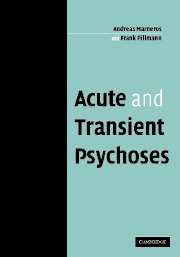Preface
Published online by Cambridge University Press: 07 August 2009
Summary
The road to the modern definitions of Brief and Acute Psychoses has been very long. Efforts to define and understand such brief, acute and good prognosis psychoses are very old-fashioned. Certainly, the definitions of ICD-10 for ‘Acute and Transient Psychotic Disorders’ and that of DSM-IV for ‘Brief Psychotic Disorder’ are not unchangeable and are also not final diagnoses. It could be assumed that even the present diagnostic algorithms will be changed. The main reason for the expected changes is that only very little and unsystematic research on this topic exists. We know really very little about the clinical aspects, the precipitants or the longitudinal prognosis. We hardly know anything about their aetiology, biology and genetics. But the relevance of such brief, acute, transient, good prognosis or ‘atypical’ psychoses for researchers and for clinicians is clear. No serious biological, genetic, pharmacological, prognostic and clinical research is possible if we do not have exact definitions or if we do not have exactly defined homogeneous groups of patients. Voluminous, diffuse and elastic groups of mental disorders called schizophrenia or affective disorders are a main handicap for effective research. But we also need exact clinical diagnoses and psychopathological understanding of the so-called ‘atypical psychoses’ because of clinical, therapeutic and prognostic aspects affecting long-term plans of patients and their relatives. Future research must seek etiological, biological or genetic similarities and differences between the ‘atypical’ and ‘typical’ psychoses. This book might be a contribution to such efforts.
- Type
- Chapter
- Information
- Acute and Transient Psychoses , pp. ixPublisher: Cambridge University PressPrint publication year: 2004

